
Concept explainers
Interpretation:
The series of equations for the preparation of each of the given compound from the designated starting material using suitable organic or inorganic reagents is to be written.
Concept introduction:
The conjugate base of alkyne acts as a good nucleophile. On reaction with primary
In hydration of alkynes, a molecule of water gets added to a molecule of alkyne.Hydrogen atom gets attached to the less substituted triple bonded carbon atom, and hydroxyl groupgetsbonded to the more substituted triple bonded carbon atom and forms a
Geminal and vicinal dihalides, on reaction with a strong base, undergo double dehydrohalogenation and form alkynes.
On halogenation, alkynes form vicinal dihalides and, on reaction with hydrogen halides, they form geminal dihalides in two steps.
Primary alcohol can be converted to primary alkyl bromide by reaction with sodium bromide in acidic condition.
Answer to Problem 36P
Solution:
a) 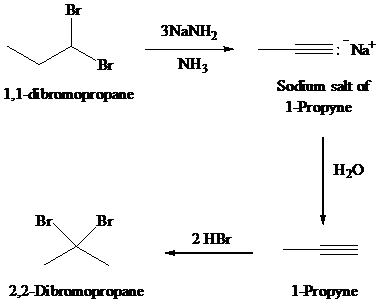
b) 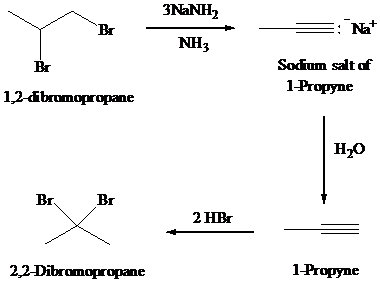
c) 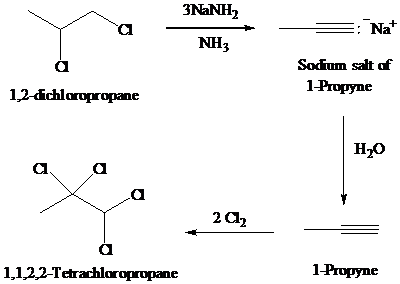
d) 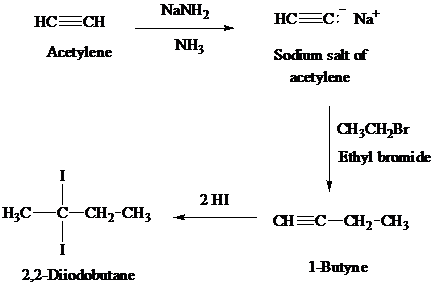
e) 
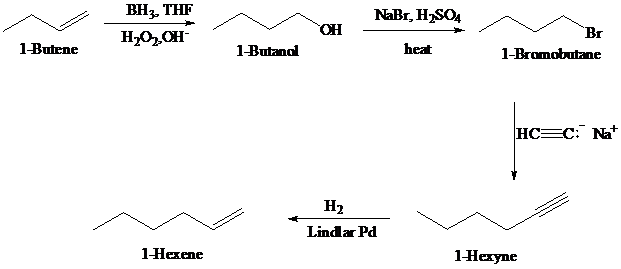
f) 
g) 
h) 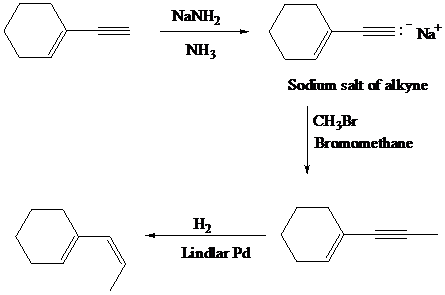
Explanation of Solution
a)
The
The synthesis of

b)
The
The synthesis of
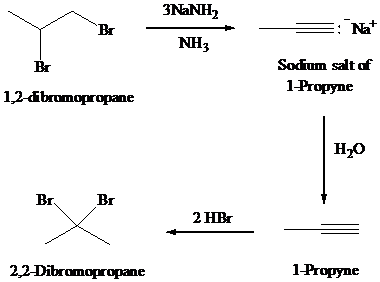
c)
The
The synthesis of
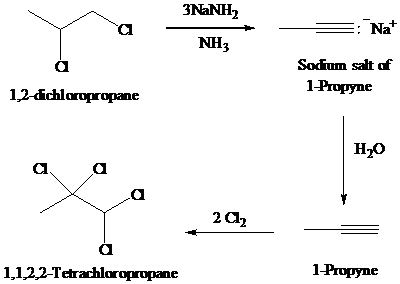
d)
Acetylene on treatment with sodium amide, gives sodium salt of acetylene. The sodium salt of acetylene on treatment with ethyl bromide gives
The synthesis of

e)
Acetylene on treatment with sodium amide, gives sodium salt of acetylene. In presence of organoboron,
The synthesis of


f)
In presence of organoboron,
The synthesis of

g)
Cyclopentadecene on halogenation with
The synthesis of

h) 
In presence of base sodium amide, the given alkyne gives sodium salt of alkyne. The sodium salt of alkyne on treatment with bromomethane adds one methyl group to alkyne, which on partial hydrogenation with Lindlar catalyst gives required cis alkene.
The synthetic route is as follows:

Want to see more full solutions like this?
Chapter 9 Solutions
ORGANIC CHEMISTRY-PACKAGE >CUSTOM<
- Predict the major products of this organic reaction: H OH 1. LiAlH4 2. H₂O ? Note: be sure you use dash and wedge bonds when necessary, for example to distinguish between major products with different stereochemistry. Click and drag to start drawing a structure. G C टेarrow_forwardFor each reaction below, decide if the first stable organic product that forms in solution will create a new C-C bond, and check the appropriate box. Next, for each reaction to which you answered "Yes" to in the table, draw this product in the drawing area below. Note for advanced students: for this problem, don't worry if you think this product will continue to react under the current conditions - just focus on the first stable product you expect to form in solution. NH2 CI MgCl ? Will the first product that forms in this reaction create a new CC bond? Yes No MgBr ? Will the first product that forms in this reaction create a new CC bond? Yes No G टेarrow_forwardFor each reaction below, decide if the first stable organic product that forms in solution will create a new CC bond, and check the appropriate box. Next, for each reaction to which you answered "Yes" to in the table, draw this product in the drawing area below. Note for advanced students: for this problem, don't worry if you think this product will continue to react under the current conditions - just focus on the first stable product you expect to form in solution. དྲ。 ✗MgBr ? O CI Will the first product that forms in this reaction create a new C-C bond? Yes No • ? Will the first product that forms in this reaction create a new CC bond? Yes No × : ☐ Xarrow_forward
- Predict the major products of this organic reaction: OH NaBH4 H ? CH3OH Note: be sure you use dash and wedge bonds when necessary, for example to distinguish between major products with different stereochemistry. Click and drag to start drawing a structure. ☐ : Sarrow_forwardPredict the major products of this organic reaction: 1. LIAIHA 2. H₂O ? Note: be sure you use dash and wedge bonds when necessary, for example to distinguish between major products with different stereochemistry. Click and drag to start drawing a structure. X : ☐arrow_forwardFor each reaction below, decide if the first stable organic product that forms in solution will create a new C - C bond, and check the appropriate box. Next, for each reaction to which you answered "Yes" to in the table, draw this product in the drawing area below. Note for advanced students: for this problem, don't worry if you think this product will continue to react under the current conditions - just focus on the first stable product you expect to form in solution. NH2 tu ? ? OH Will the first product that forms in this reaction create a new CC bond? Yes No Will the first product that forms in this reaction create a new CC bond? Yes No C $ ©arrow_forward
- As the lead product manager at OrganometALEKS Industries, you are trying to decide if the following reaction will make a molecule with a new C-C bond as its major product: 1. MgCl ? 2. H₂O* If this reaction will work, draw the major organic product or products you would expect in the drawing area below. If there's more than one major product, you can draw them in any arrangement you like. Be sure you use wedge and dash bonds if necessary, for example to distinguish between major products with different stereochemistry. If the major products of this reaction won't have a new CC bond, just check the box under the drawing area and leave it blank. Click and drag to start drawing a structure. This reaction will not make a product with a new CC bond. G marrow_forwardIncluding activity coefficients, find [Hg22+] in saturated Hg2Br2 in 0.00100 M NH4 Ksp Hg2Br2 = 5.6×10-23.arrow_forwardgive example for the following(by equation) a. Converting a water insoluble compound to a soluble one. b. Diazotization reaction form diazonium salt c. coupling reaction of a diazonium salt d. indacator properties of MO e. Diazotization ( diazonium salt of bromobenzene)arrow_forward
- 2-Propanone and ethyllithium are mixed and subsequently acid hydrolyzed. Draw and name the structures of the products.arrow_forward(Methanesulfinyl)methane is reacted with NaH, and then with acetophenone. Draw and name the structures of the products.arrow_forward3-Oxo-butanenitrile and (E)-2-butenal are mixed with sodium ethoxide in ethanol. Draw and name the structures of the products.arrow_forward
 Organic ChemistryChemistryISBN:9781305580350Author:William H. Brown, Brent L. Iverson, Eric Anslyn, Christopher S. FootePublisher:Cengage Learning
Organic ChemistryChemistryISBN:9781305580350Author:William H. Brown, Brent L. Iverson, Eric Anslyn, Christopher S. FootePublisher:Cengage Learning
